As a coffee enthusiast who’s spent countless mornings perfecting my espresso, I’ve tested the Philips 3200, 4300, and 5400 to find out which one deserves a spot on your counter.
My goal is to break down their features, weigh their pros and cons, and help you decide which machine aligns with your coffee cravings and lifestyle.
From sleek designs to user-friendly interfaces, these super-automatic espresso machines promise café-quality drinks at home. Let’s explore what sets them apart and find the best fit for you.
A Brief Comparison Table
| Feature | Philips 3200 | Philips 4300 | Philips 5400 |
| Drink Options | 5 (Espresso, Coffee, Cappuccino, Latte Macchiato, Americano or Iced Coffee) | 8 (Espresso, Ristretto, Coffee, Americano, Cappuccino, Latte Macchiato, Café au Lait, Caffè Crema) | 12 (Adds Flat White, Espresso Lungo, Café Latte, Travel Mug) |
| Milk Frothing | LatteGo or Classic Steam Wand | LatteGo or Classic Steam Wand | LatteGo or Classic Steam Wand |
| User Profiles | None | 2 + Guest | 4 + Guest |
| Display | Basic Touch Display with LEDs | TFT Display with Scrollable Menu | Full-Color TFT Display |
| Grind Settings | 12 (Ceramic Burr) | 12 (Ceramic Burr) | 12 (Ceramic Burr) |
| Extra Shot Mode | No | Yes (Select Models) | Yes |
| Quick Clean Program | No | Yes | Yes |
| Water Tank Capacity | 1.8L | 1.8L | 1.8L |
| Bean Hopper Capacity | 275g | 275g | 275g |
| Price Range (USD) | $600-$800 | $800-$1000 | $1000-$1200 |
| Best For | Beginners, Budget-Conscious | Intermediate Users, Customization | Coffee Enthusiasts, Large Households |
My Journey With Philips Espresso Machines
I’ve always been a coffee lover, but my mornings transformed when I switched from a manual espresso maker to a super-automatic machine. No more grinding beans by hand or steaming milk with a wand that felt like a part-time job.
The Philips 3200, 4300, and 5400 caught my attention for their promise of café-quality coffee with minimal effort. Over the past few months, I’ve used each one extensively, brewing everything from bold espressos to creamy cappuccinos.
My kitchen became a testing ground, and I’m excited to share what I’ve learned about these machines’ strengths, quirks, and differences.
Philips 3200: The Simple, Reliable Workhorse
The Philips 3200 feels like the friendly, no-nonsense friend in the lineup. It’s designed for people who want great coffee without overcomplicating things. Available in three versions—Classic Steam Wand, LatteGo, and LatteGo Iced Coffee—it offers versatility at a budget-friendly price, typically around $600-$800.
Key Features of the Philips 3200
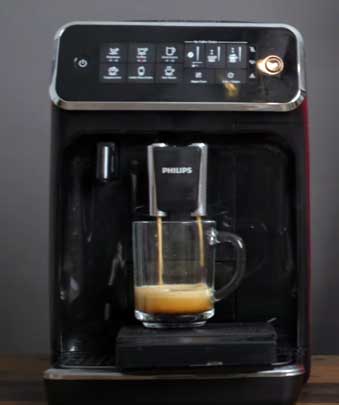
The 3200 comes with a ceramic burr grinder offering 12 grind settings, which I found plenty for tweaking the flavor of my espresso.
Its 1.8-liter water tank and 275-gram bean hopper are standard across all three models, meaning you won’t need to refill constantly unless you’re hosting a coffee-fueled party.
The Aroma Extract System ensures balanced extraction, delivering rich, consistent shots every time.
The LatteGo version, my personal favorite, features a two-part milk frothing system that’s a breeze to clean—just rinse it under the tap, and you’re done.
The Classic Steam Wand version requires manual frothing, which I enjoyed for its hands-on feel but found less convenient for quick mornings.
The Iced Coffee variant adjusts brewing temperature for a cooler shot that doesn’t melt ice too fast, perfect for summer days.
The interface is straightforward, with a touch display and LED indicators. You get five drink options: espresso, coffee, cappuccino, latte macchiato, and either Americano or iced coffee, depending on the model.
Customization is basic but effective—three strength levels, adjustable volume, and temperature settings. I loved how quickly I could dial in my preferred espresso strength without fuss.
Pros of The Philips 3200
- Affordability: At $600-$800, it’s the most budget-friendly of the trio, offering excellent value for beginners.
- Ease of Use: The intuitive touch display makes brewing a breeze, even if you’re half-asleep.
- Compact Design: Its sleek, glossy finish fits neatly on my counter without hogging space.
- Consistent Coffee: The Aroma Extract System delivers full-bodied espresso with thick crema, rivaling pricier machines.
- Low Maintenance: The removable brew group and automatic rinsing cycle keep cleaning simple. The LatteGo system is dishwasher-safe, saving me time.
- Iced Coffee Option: The dedicated iced coffee setting is a game-changer for cold brew fans like me.
Cons of The Philips 3200
- Limited Drink Options: With only five drinks, it lacks the variety of the 4300 and 5400. If you love niche drinks like flat white, you’ll need to upgrade.
- No User Profiles: You can’t save custom settings, which is a bummer if multiple people use the machine.
- Basic Display: The LED-based interface works fine but feels dated compared to the 4300’s TFT screen.
- No Extra Shot Mode: Unlike the 4300 and 5400, there’s no way to boost coffee strength with an extra shot in one go.
- Foam Consistency: The LatteGo’s milk froth is creamy but can be overly foamy for microfoam lovers, especially for latte art.
My experience with the 3200 was delightful for its simplicity. Mornings became stress-free—I’d press a button, and within a minute, I had a rich espresso with a velvety crema. However, when my partner wanted a weaker coffee, we had to manually adjust settings each time, which got old fast.
Philips 4300: The Balanced Middle Ground
The Philips 4300 steps things up, offering more features and customization for those willing to spend a bit more, typically $800-$1,000. It’s the middle child that tries to please everyone, and it mostly succeeds. Like the 3200, it comes in LatteGo and Classic Steam Wand versions.
Key Features of The Philips 4300
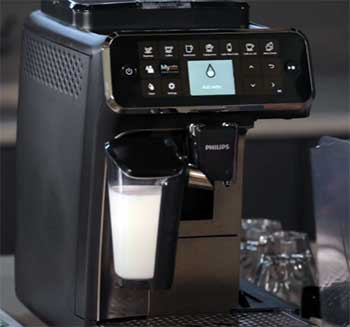
The 4300 shares the same 1.8-liter water tank, 275-gram bean hopper, and 12-setting ceramic grinder as the 3200.
What sets it apart is its expanded drink menu—eight options, including espresso, ristretto, coffee, Americano, cappuccino, latte macchiato, café au lait, and caffè crema.
The addition of ristretto, a shorter, bolder espresso shot, was a highlight for me, as I love intense flavors.
The TFT display is a major upgrade, offering a scrollable menu that’s easy to navigate with up, down, and right arrow buttons.
It shows clear status messages, like when the machine is rinsing or needs water, which I found more user-friendly than the 3200’s blinking LEDs.
The 4300 also introduces two user profiles plus a guest profile, letting me save my strong espresso settings while my partner stored a milder cappuccino recipe.
The Extra Shot mode (available on select models like the EP4347/94) adds a 30ml espresso shot to any drink, boosting intensity without bitterness. I used this for milk-based drinks like lattes, which felt richer without needing a second brew cycle.
The quick clean program for the LatteGo system is another perk, making maintenance even easier than the 3200.
Pros of The Philips 4300
- More Drink Options: Eight beverages give you more variety, including ristretto and café au lait, catering to diverse tastes.
- User Profiles: Two customizable profiles plus a guest option make it ideal for small households with different preferences.
- Intuitive Display: The TFT screen is clear and responsive, simplifying navigation and customization.
- Extra Shot Mode: Adds depth to drinks, especially milk-based ones, without extra effort.
- Quick Clean Program: The LatteGo’s automated cleaning saves time, especially for frequent milk drink users.
- AquaClean Filter: Reduces descaling needs for up to 5,000 shots, a blessing for low-maintenance folks like me.
Cons of The Philips 4300
- Higher Price: At $800-$1,000, it’s pricier than the 3200, which might not justify the added features for casual drinkers.
- No Iced Coffee Setting: Unlike the 3200’s Iced Coffee model, the 4300 lacks a dedicated cold brew option.
- Milk Froth Limitations: The LatteGo produces foamy milk, which isn’t ideal for latte art enthusiasts who prefer microfoam.
- Similar Build: The design is nearly identical to the 3200, so you’re not getting a visual upgrade for the price.
- Limited Profiles: Two user profiles might not suffice for larger households with varied preferences.
Using the 4300 felt like a step up from the 3200. I loved saving my espresso settings and switching to the guest profile for friends who wanted a quick coffee. The TFT display made tweaking settings a breeze, and the extra shot mode gave my cappuccinos a bolder kick.
However, I missed the iced coffee option during hot summer days, and the foam was sometimes too airy for my liking.
Philips 5400: The Feature-Packed Powerhouse
The Philips 5400 is the top-tier model, priced around $1,000-$1,200, and it’s designed for coffee enthusiasts who want it all. With a sleek chrome finish and advanced features, it feels like the premium choice in the lineup.
Key Features of The Philips 5400
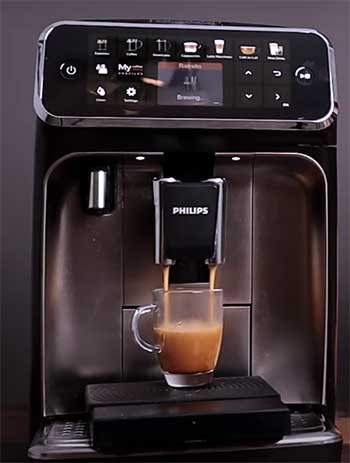
The 5400 boasts 12 drink options, adding flat white, espresso lungo, café latte, and a travel mug setting to the 4300’s lineup.
The full-color TFT display is a standout, offering a smartphone-like interface that’s intuitive and visually appealing.
I found myself enjoying the process of scrolling through drink options, almost like browsing a menu at a café.
It offers four user profiles plus a guest profile, perfect for larger households or frequent entertainers.
The Extra Shot mode is standard, enhancing drink intensity effortlessly.
The ceramic grinder, water tank, and bean hopper specs mirror the 3200 and 4300, but the 5400 adds barista lights and a transparent bean hopper for a touch of flair.
The LatteGo system performs consistently, and the quick clean program keeps it hassle-free. The 5400 also supports the AquaClean filter, minimizing descaling. I was impressed by the travel mug setting, which brews larger volumes (8.1 or 12.2 oz) for on-the-go coffee lovers.
Pros of The Philips 5400
- Extensive Drink Menu: 12 options, including flat white and travel mug, cater to diverse tastes and lifestyles.
- Advanced Display: The full-color TFT screen is responsive and modern, making customization a joy.
- Multiple User Profiles: Four profiles plus a guest option accommodate large households or frequent guests.
- Extra Shot Mode: Standard across all 5400 models, it boosts coffee intensity seamlessly.
- Premium Aesthetics: The chrome finish and barista lights give it a high-end look that elevates any kitchen.
- Travel Mug Option: Perfect for commuters who need larger coffee volumes on the go.
Cons of The Philips 5400
- Premium Price: At $1,000-$1,200, it’s a significant investment, especially if you don’t need all the drink options.
- No Iced Coffee Setting: Like the 4300, it lacks a dedicated iced coffee mode, which feels like a miss at this price.
- Bulky Design: Slightly larger than the 3200 and 4300, it takes up more counter space.
- Foam Consistency: The LatteGo’s froth is still foamy rather than microfoam, limiting latte art potential.
- Overkill for Casual Users: The extensive features may be unnecessary for those who stick to basic drinks.
The 5400 felt like a luxury experience. I loved the vibrant display and the ability to save settings for my entire family. The flat white option was a treat, delivering creamy, well-balanced drinks. However, the price tag gave me pause, especially since I rarely used all 12 drink options, and the lack of an iced coffee setting was disappointing.
Key Comparison of Philips 3200 And 4300 And 5400 Espresso Machine
To truly understand which machine suits you, let’s compare their core differences based on my experience.
- Drink Variety and Customization
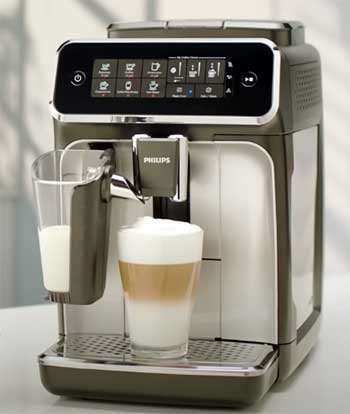
The 3200’s five drink options are sufficient for beginners or those who stick to classics like espresso and cappuccino.
The Iced Coffee version adds a unique twist, but you’re limited to basic customization (three strength levels, volume, and temperature).
The 4300’s eight drinks and five strength levels offer more flexibility, and the user profiles are a game-changer for shared households.
The 5400’s 12 drinks and four profiles take customization to the max, ideal for those who love experimenting or need variety for guests.
I found the 3200 perfect for my daily espresso and occasional cappuccino, but the 4300’s ristretto and user profiles made it more versatile for my partner’s milder preferences. The 5400’s flat white and travel mug settings were fun but felt excessive for my routine.
- Interface and Usability
The 3200’s basic touch display with LEDs is simple but functional. I never struggled to select drinks, but the lack of clear status messages meant occasional glances at the manual. The 4300’s TFT display is a significant upgrade, offering clear navigation and feedback.
The 5400’s full-color TFT screen feels like a luxury gadget, making it the most intuitive but potentially overwhelming for tech-averse users.
I appreciated the 4300’s balance of clarity and simplicity, while the 5400’s interface was almost too fancy for my morning rush. The 3200’s straightforward controls were reliable but felt basic after using the others.
- Milk Frothing Performance
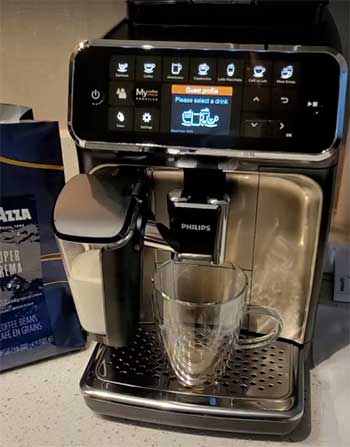
All three models offer LatteGo or Classic Steam Wand options.
The LatteGo system is a standout for its ease of use and cleaning, producing creamy froth in seconds.
However, I noticed the 5400’s froth was slightly more consistent, especially for multiple drinks in a row.
The Classic Steam Wand requires manual frothing, which I enjoyed for its control but found time-consuming.
The 3200’s Iced Coffee model pairs well with cold milk, but the standard LatteGo’s foamy texture isn’t ideal for latte art across all models.
- Maintenance and Build Quality
All three machines share a durable plastic casing, 15-bar pump, and ceramic grinder, ensuring consistent espresso quality. The 3200’s automatic rinsing and removable brew group make maintenance easy, but the 4300 and 5400 add a quick clean program for the LatteGo system, saving time.
The AquaClean filter, available on all models, reduces descaling needs, which I found incredibly convenient. The 5400’s chrome finish and barista lights add a premium touch, but the 3200 and 4300’s glossy or matte finishes are equally sleek.
- Price vs. Value
The 3200’s $600-$800 price makes it the best value for beginners or budget-conscious buyers. The 4300’s $800-$1,000 range feels justified for its added features and profiles, offering a sweet spot for most users.
The 5400’s $1,000-$1,200 price is steep, and unless you need the extra drinks or profiles, it may not be worth the splurge.
My Personal Recommendation
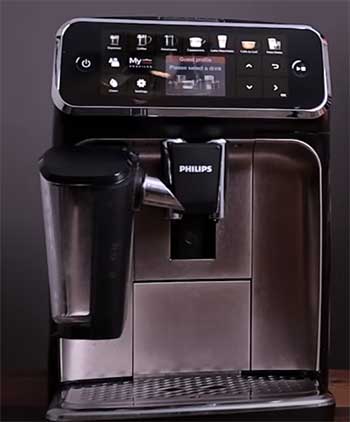
After testing all three, I lean toward the Philips 4300 for its balance of features, customization, and value.
The 3200 is fantastic for beginners or those who want simplicity without sacrificing quality.
It’s my go-to when I’m on a budget or just want a quick, reliable espresso.
The 5400 is a dream for coffee enthusiasts or large households, but its price and complexity might be overkill for casual drinkers.
The 4300 hits the sweet spot, offering enough variety and personalization without overwhelming me with options I don’t need.
Frequently Asked Questions (FAQ)
The Philips 5400 offers 12 drink options (including flat white and travel mug) compared to the 3200’s 5. It has a full-color TFT display, four user profiles, and Extra Shot mode, while the 3200 has a basic touch display, no profiles, and no Extra Shot. The 5400 is pricier ($1,000-$1,200) versus the 3200’s $600-$800.
There is no Philips 4400 model in the current lineup. You might be referring to the 4300 or 5400. The 4300 has 8 drink options and two user profiles, while the 5400 has 12 drinks and four profiles, with a full-color display and premium aesthetics.
The 5400 is worth it if you value extensive drink variety, multiple user profiles, and a premium interface. For casual drinkers, the 3200 or 4300 offers similar coffee quality at a lower price.
The 5400 lacks a dedicated iced coffee setting, unlike the 3200’s Iced Coffee model. You can brew coffee over ice, but it’s not optimized for cold drinks.
Conclusion: Which Philips Machine Is Right For You?
You’ve got three solid choices with the Philips 3200, 4300, and 5400, and I hope my experience helps you pick the one that fits your coffee routine. If you’re after affordability and simplicity, the 3200 delivers consistent, delicious coffee without breaking the bank.
If you want more control and variety, the 4300 offers a perfect balance for most households. For those craving a premium, feature-packed experience, the 5400 is your go-to, provided you’re willing to pay for it. Whichever you choose, you’re getting a reliable machine that makes café-quality coffee a reality at home.
Happy brewing!
